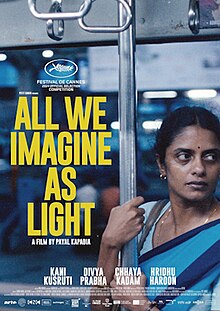
Payal Kapadia’s directorial ‘All We Imagine as Light’ has been the talk of the town ever since it won the Cannes Grand Prix award and will be released on OTT platforms on 3rd January 2025. Indian cinema, known for its vibrant diversity, offers a spectrum ranging from Bollywood blockbusters to the nuanced storytelling of art-house films. Yet, despite earning international acclaim, Indian art-house films remain largely ignored by mainstream audiences. This persistent gap underscores the challenges independent films face in a country dominated by commercial cinema. Let’s explore why art-house cinema in India struggles for recognition and what can be done to bridge this divide.
The Escapist Nature of Indian Cinema
One major reason why art-house films are overlooked is the cultural inclination towards escapist entertainment.
Tradition of Escapism: Generations of Indian audiences have grown accustomed to cinema as a medium of joy and relief, further cementing the preference for mainstream storytelling.
Cinema as a Gateway to Fantasy: For many, Bollywood’s larger-than-life stories, melodious songs, and happy endings provide an escape from everyday struggles. Indian independent films, by contrast, often delve into harsh realities and complex social issues, which can feel too heavy for viewers seeking light-hearted entertainment.
Challenges in Accessibility and Promotion
Art-house cinema in India faces significant barriers to reach audiences:
- Limited Theatrical Presence: Mainstream Indian cinema monopolizes theater screens, leaving little room for niche films. Indian art-house films often have restricted releases, reducing their visibility.
- Marketing Constraints: Unlike Bollywood films with massive promotional budgets, independent films rely on minimal resources, resulting in limited public awareness.
- Regional and Linguistic Barriers: With art-house films frequently made in regional languages, they struggle to cross-linguistic divides and connect with pan-Indian audiences.
Bollywood’s Dominance in Indian Cinema
Bollywood’s overwhelming presence often overshadows the efforts of art-house and independent filmmakers.
- Celebrity-Driven Culture: Indian audiences’ fascination with star power plays a crucial role in deciding a film’s success. Indian independent films, which prioritize storytelling over star-studded casts, miss out on this advantage.
- Formulaic Expectations: Bollywood’s formula of romance, action, and music caters to mass appeal, while art-house cinema in India takes risks with unconventional narratives, alienating some viewers.
Misconceptions About Art-House Films
A significant reason for the lack of popularity of art-house cinema in India is its perception as “inaccessible.”
- Stereotypes: Art-house films are often labeled as “elitist” or “too intellectual,” deterring potential audiences.
- Lack of Mass Appeal: These films frequently focus on niche themes, such as social injustices or existential dilemmas, which may not resonate with the mainstream crowd.
Economic Barriers to Independent Films in India
The financial pressures on art-house cinema in India are immense:
- Profit-Driven Industry: Producers and distributors prioritize commercial films with guaranteed returns over riskier projects like Indian independent films.
- Distribution Costs: Securing theater slots for art-house films is expensive, especially when competing against big-budget Bollywood productions.
OTT Challenges: Although streaming platforms like Netflix and MUBI provide a space for niche films, they often prioritize content with mass appeal, making it harder for art-house films to stand out.
Low Film Literacy Among Audiences
A lack of exposure to diverse cinema and limited film education contributes to the underappreciation of art-house films.
- Limited Exposure to Global Cinema: Many Indian viewers are unfamiliar with international cinematic styles that emphasize subtlety and layered storytelling, which are common in art-house cinema.
Solutions to Promote Art-House Cinema in India
Despite these challenges, there are ways to elevate the status of Indian art-house films:
- Increased Accessibility: Ensuring wider theatrical releases and better OTT categorization can help art-house films reach more viewers.
- Government Support: Subsidies and grants for art-house filmmakers can reduce financial barriers and encourage innovation in storytelling.
- Targeted Marketing: Leveraging social media campaigns can increase visibility for art-house cinema in India, even with limited budgets.
The neglect of Indian art-house films by mainstream audiences stems from deep-rooted cultural preferences, systemic barriers, and economic challenges. However, with the rise of streaming platforms, increased awareness, and strategic promotion, the tide can shift. By embracing diverse storytelling and encouraging film literacy, India’s cinematic landscape can evolve to give art-house films the respect they deserve. As audiences become more discerning, art-house cinema in India could finally find its place alongside mainstream commercial films, enriching the country’s cinematic heritage.
Tricolon Content Studio
